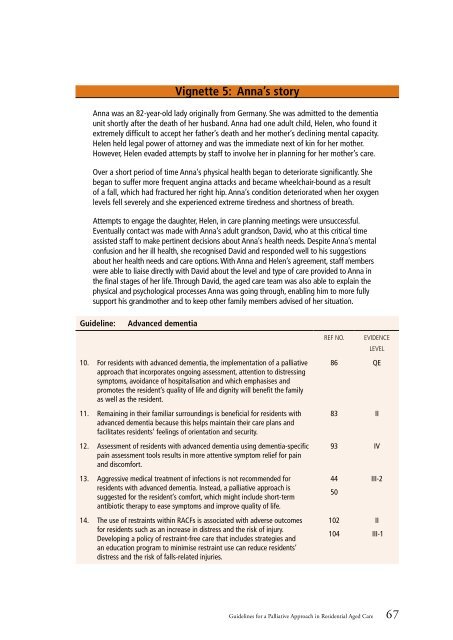Guidelines for a Palliative Approach in Residential Aged Care
Guidelines for a Palliative Approach in Residential Aged Care
Guidelines for a Palliative Approach in Residential Aged Care
You also want an ePaper? Increase the reach of your titles
YUMPU automatically turns print PDFs into web optimized ePapers that Google loves.
Vignette 5: Anna’s story<br />
Anna was an 82-year-old lady orig<strong>in</strong>ally from Germany. She was admitted to the dementia<br />
unit shortly after the death of her husband. Anna had one adult child, Helen, who found it<br />
extremely difficult to accept her father’s death and her mother’s decl<strong>in</strong><strong>in</strong>g mental capacity.<br />
Helen held legal power of attorney and was the immediate next of k<strong>in</strong> <strong>for</strong> her mother.<br />
However, Helen evaded attempts by staff to <strong>in</strong>volve her <strong>in</strong> plann<strong>in</strong>g <strong>for</strong> her mother’s care.<br />
Over a short period of time Anna’s physical health began to deteriorate significantly. She<br />
began to suffer more frequent ang<strong>in</strong>a attacks and became wheelchair-bound as a result<br />
of a fall, which had fractured her right hip. Anna’s condition deteriorated when her oxygen<br />
levels fell severely and she experienced extreme tiredness and shortness of breath.<br />
Attempts to engage the daughter, Helen, <strong>in</strong> care plann<strong>in</strong>g meet<strong>in</strong>gs were unsuccessful.<br />
Eventually contact was made with Anna’s adult grandson, David, who at this critical time<br />
assisted staff to make pert<strong>in</strong>ent decisions about Anna’s health needs. Despite Anna’s mental<br />
confusion and her ill health, she recognised David and responded well to his suggestions<br />
about her health needs and care options. With Anna and Helen’s agreement, staff members<br />
were able to liaise directly with David about the level and type of care provided to Anna <strong>in</strong><br />
the f<strong>in</strong>al stages of her life. Through David, the aged care team was also able to expla<strong>in</strong> the<br />
physical and psychological processes Anna was go<strong>in</strong>g through, enabl<strong>in</strong>g him to more fully<br />
support his grandmother and to keep other family members advised of her situation.<br />
Guidel<strong>in</strong>e:<br />
Advanced dementia<br />
10. For residents with advanced dementia, the implementation of a palliative<br />
approach that <strong>in</strong>corporates ongo<strong>in</strong>g assessment, attention to distress<strong>in</strong>g<br />
symptoms, avoidance of hospitalisation and which emphasises and<br />
promotes the resident’s quality of life and dignity will benefit the family<br />
as well as the resident.<br />
11. Rema<strong>in</strong><strong>in</strong>g <strong>in</strong> their familiar surround<strong>in</strong>gs is beneficial <strong>for</strong> residents with<br />
advanced dementia because this helps ma<strong>in</strong>ta<strong>in</strong> their care plans and<br />
facilitates residents’ feel<strong>in</strong>gs of orientation and security.<br />
12. Assessment of residents with advanced dementia us<strong>in</strong>g dementia-specific<br />
pa<strong>in</strong> assessment tools results <strong>in</strong> more attentive symptom relief <strong>for</strong> pa<strong>in</strong><br />
and discom<strong>for</strong>t.<br />
13. Aggressive medical treatment of <strong>in</strong>fections is not recommended <strong>for</strong><br />
residents with advanced dementia. Instead, a palliative approach is<br />
suggested <strong>for</strong> the resident’s com<strong>for</strong>t, which might <strong>in</strong>clude short-term<br />
antibiotic therapy to ease symptoms and improve quality of life.<br />
14. The use of restra<strong>in</strong>ts with<strong>in</strong> RACFs is associated with adverse outcomes<br />
<strong>for</strong> residents such as an <strong>in</strong>crease <strong>in</strong> distress and the risk of <strong>in</strong>jury.<br />
Develop<strong>in</strong>g a policy of restra<strong>in</strong>t-free care that <strong>in</strong>cludes strategies and<br />
an education program to m<strong>in</strong>imise restra<strong>in</strong>t use can reduce residents’<br />
distress and the risk of falls-related <strong>in</strong>juries.<br />
Ref No. Evidence<br />
level<br />
86 QE<br />
83 II<br />
93 IV<br />
44 III-2<br />
50<br />
102 II<br />
104 III-1<br />
<strong>Guidel<strong>in</strong>es</strong> <strong>for</strong> a <strong>Palliative</strong> <strong>Approach</strong> <strong>in</strong> <strong>Residential</strong> <strong>Aged</strong> <strong>Care</strong> 67
















